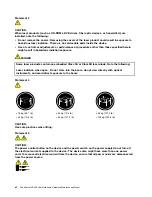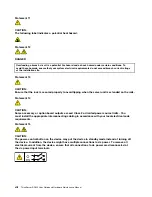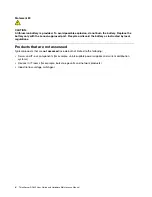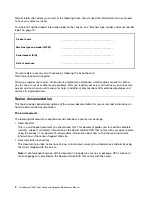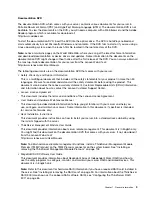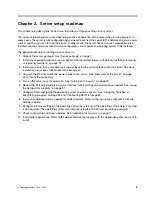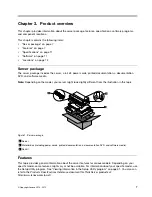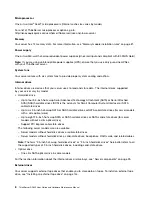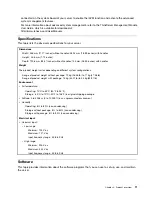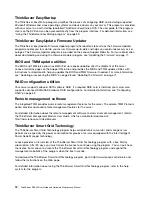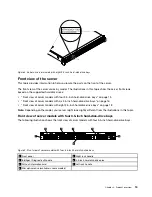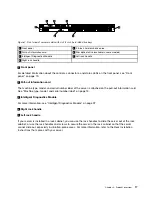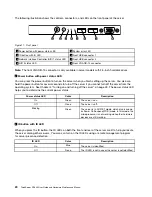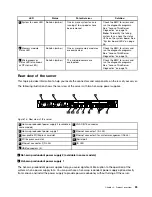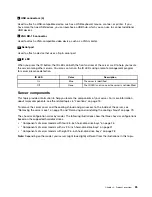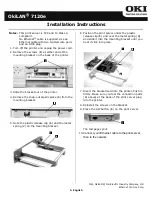
The BIOS Setup Utility program helps you view the server information and configure the server in the
pre-operating system environment. See “Using the Setup Utility program” on page 51.
– TMM (also known as BMC) and Intelligent Platform Management Interface (IPMI) 2.0
The system board platform management subsystem is based on the integrated TMM features. The
TMM is a management chip that is integrated on the system board of your server. With the TMM
chip, no matter what condition the server operating system is in and no matter if the server is on or
off, as long as the server is connected to network and an ac power source, the interaction with the
TMM-controlled servers can be achieved through system network. The user can obtain the server
hardware health information and system event log (SEL), and is able to conduct the operations
including turning on or off the server, restarting the server, and so on. This part of server management
is independent of the operating system and is called out-of-band management.
The system board platform management subsystem consists of the integrated TMM, communication
buses, sensors, the BIOS, and server management firmware. It is responsible for error reporting,
system power control, thermal monitoring, system fan control, and other management features. The
TMM provides system management and monitoring features based on the IPMI 2.0 specification. IPMI
helps lower the overall costs of server management. You can find more information about IPMI 2.0
from the Web site of Intel. The TMM also supports some non-IPMI features, such as the Dynamic Host
Configuration Protocol (DHCP) and the Platform Environment Control Interface (PECI), to provide
more system management functions.
You can find the default user name, password, and other information for the TMM in the
ThinkServer
Management Module User Guide
, which is available for download at:
http://www.lenovo.com/UserManuals
– Hot-swap feature
Your server supports hot-swap hard disk drives and hot-swap redundant power supplies. With the
hot-swap feature, you can install, remove, or replace a hot-swap device without turning off the server.
– Preboot Execution Environment (PXE)
The Intel PXE technology enables you to start your computers, load an operating system, or deploy
executable images from a remote server by using a network interface. The operation can be done
independently of local data storage devices (such as hard disk drives) or operating systems.
– Redundant Array of Independent Disks (RAID)
Your server supports onboard SATA software RAID. If a required RAID card is installed, your server
also supports advanced SATA/SAS hardware RAID configurations. For detailed information, see
“Configuring RAID” on page 62.
– Status light-emitting diodes (LEDs) and diagnostic LEDs
For more information about the LEDs for your server, refer to the related topics in “Locations” on
page 13.
– Software programs
For more information about the software programs, see “Software” on page 11.
– Wake on LAN
When the Wake on LAN feature is enabled on a computer that is connected to a LAN, a network
administrator can remotely turn on or wake up the computer from a management console using remote
network management software. Besides, many other functions, such as data transfer and software
updates, can be performed remotely without remote attendance and can be done after normal working
hours and on weekends to save time and increase productivity.
•
Advanced system management features
The advanced system management features are only available when the TMM detects the presence of a
ThinkServer Management Module Premium (TMM Premium), which also is known as integrated keyboard,
video, and mouse (iKVM) key. The TMM Premium is a remote management module. You can purchase
a TMM Premium from Lenovo and install it on the TMM Premium connector (also known as iKVM
10
ThinkServer RD340 User Guide and Hardware Maintenance Manual
Summary of Contents for ThinkServer RD340
Page 18: ...6 ThinkServer RD340 User Guide and Hardware Maintenance Manual ...
Page 84: ...72 ThinkServer RD340 User Guide and Hardware Maintenance Manual ...
Page 188: ...176 ThinkServer RD340 User Guide and Hardware Maintenance Manual ...
Page 198: ...186 ThinkServer RD340 User Guide and Hardware Maintenance Manual ...
Page 214: ...202 ThinkServer RD340 User Guide and Hardware Maintenance Manual ...
Page 215: ......
Page 216: ......

